-
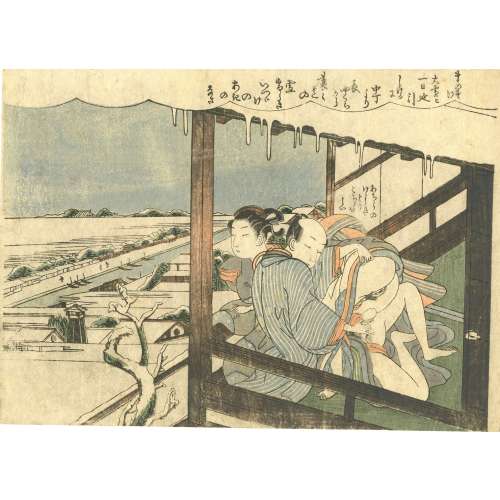 Unsigned print, attributed to Suzuki Harunobu. Erotic scene on open veranda with a winter landscape on background.
Unsigned print, attributed to Suzuki Harunobu. Erotic scene on open veranda with a winter landscape on background. -
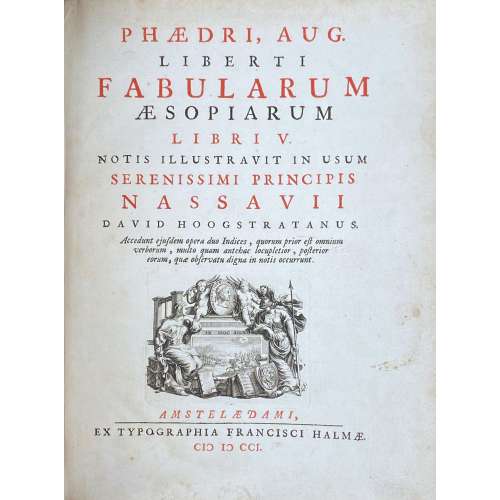 Phaedri, Aug. Liberti Fabularum Aesopiarum libri V / notis illustravit in usum serenissimi principis Nassavii David Hoogstratanus. Accedunt ejusdem opera duo indices, quorum prior est omnium verborum, multo quam antehac locupletior, posterior eorum, quae observatu digna in notis occurunt. — Amstelaedami : Ex Typographia Francisci Halmae, MDCCI [1701]. — pp.: [1] title, [1] (portr.), [32] 160, [84], 18 leaves of plates. Vita Phaedri is written by Johannes Schefferus (February 2, 1621 – March 26, 1679). Appendix fabularum is written by Marquard Gude (Gudius) (1 February 1635 – 26 November 1689). Gaius Julius Phaedrus was a 1st-century CE Roman fabulist and the first versifier of a collection of Aesop's fables into Latin. David van Hoogstraten (Rotterdam, March 14, 1658 - Amsterdam, November 21, 1724), a physician, poet and linguist, annotated the fables and dedicated them to Johan Willem Friso van Oranje-Nassau (14 August 1687 – 14 July 1711). The book was published in Amsterdam by François Halma (Langerak, January 3, 1653 - Leeuwarden, January 13, 1722), a Dutch printer, publisher and bookseller, with a portrait of Prince of Orange-Nassau, engraved by Pieter van Gunst (Dutch, Amsterdam 1659–1724) after Bernard Vaillant (Dutch, Lille 1632–1698 Leyden). The title page was engraved by P. Boutats after Jan Goeree (Dutch, Middelburg 1670–1731 Amsterdam). The edition is adorned throughout with 18 plates, each with 8 médaillons, designed and engraved by Jan van Vianen (Dutch, 1660–1726), and with vignettes, head- and tailpieces, inhabited initials, etc. Contemporary vellum over boards, title in red and back, red edges, 4to, 26 x 20 cm. Seller's description:4to, engraved general title, letterpress red & black title page with allegorical engraved vignette. 18 full-page copper-engraved plates by Jan van Vianen, each featuring six circular images, and 38 in-text reproductions, engraved decorative initials, and head- and tailpieces. Phaedrus (15 BC - 50 AD, Italy), was a "Roman fabulist, the first writer to Latinize whole books of fables, producing free versions in the iambic metre of Greek prose fables then circulating under the name of Aesop." (Ency. Brit.). This deluxe edition was specially created for the Prince of Nassau, profusely illustrated with fine engravings. Dibdin spoke highly of it in his Greek and Latin Classics (4th edition): "I have always considered this as a correct and very sumptuous edition. It is ornamented with a great number of small plates, or medallions, in which the subject of the fable is very ably and spiritedly executed.Ref.: Metropolitan Museum; Musée Médard
Phaedri, Aug. Liberti Fabularum Aesopiarum libri V / notis illustravit in usum serenissimi principis Nassavii David Hoogstratanus. Accedunt ejusdem opera duo indices, quorum prior est omnium verborum, multo quam antehac locupletior, posterior eorum, quae observatu digna in notis occurunt. — Amstelaedami : Ex Typographia Francisci Halmae, MDCCI [1701]. — pp.: [1] title, [1] (portr.), [32] 160, [84], 18 leaves of plates. Vita Phaedri is written by Johannes Schefferus (February 2, 1621 – March 26, 1679). Appendix fabularum is written by Marquard Gude (Gudius) (1 February 1635 – 26 November 1689). Gaius Julius Phaedrus was a 1st-century CE Roman fabulist and the first versifier of a collection of Aesop's fables into Latin. David van Hoogstraten (Rotterdam, March 14, 1658 - Amsterdam, November 21, 1724), a physician, poet and linguist, annotated the fables and dedicated them to Johan Willem Friso van Oranje-Nassau (14 August 1687 – 14 July 1711). The book was published in Amsterdam by François Halma (Langerak, January 3, 1653 - Leeuwarden, January 13, 1722), a Dutch printer, publisher and bookseller, with a portrait of Prince of Orange-Nassau, engraved by Pieter van Gunst (Dutch, Amsterdam 1659–1724) after Bernard Vaillant (Dutch, Lille 1632–1698 Leyden). The title page was engraved by P. Boutats after Jan Goeree (Dutch, Middelburg 1670–1731 Amsterdam). The edition is adorned throughout with 18 plates, each with 8 médaillons, designed and engraved by Jan van Vianen (Dutch, 1660–1726), and with vignettes, head- and tailpieces, inhabited initials, etc. Contemporary vellum over boards, title in red and back, red edges, 4to, 26 x 20 cm. Seller's description:4to, engraved general title, letterpress red & black title page with allegorical engraved vignette. 18 full-page copper-engraved plates by Jan van Vianen, each featuring six circular images, and 38 in-text reproductions, engraved decorative initials, and head- and tailpieces. Phaedrus (15 BC - 50 AD, Italy), was a "Roman fabulist, the first writer to Latinize whole books of fables, producing free versions in the iambic metre of Greek prose fables then circulating under the name of Aesop." (Ency. Brit.). This deluxe edition was specially created for the Prince of Nassau, profusely illustrated with fine engravings. Dibdin spoke highly of it in his Greek and Latin Classics (4th edition): "I have always considered this as a correct and very sumptuous edition. It is ornamented with a great number of small plates, or medallions, in which the subject of the fable is very ably and spiritedly executed.Ref.: Metropolitan Museum; Musée Médard -
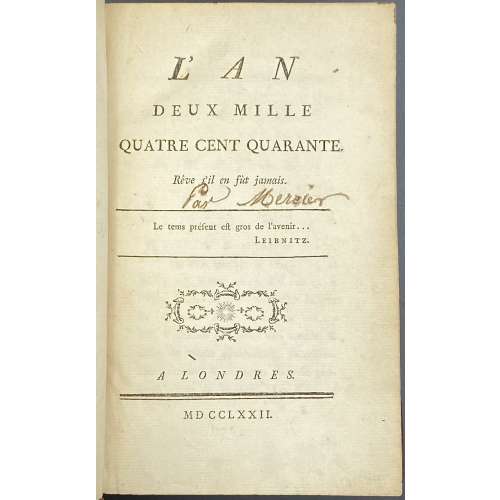 Title page: L'AN DEUX MILLE QUATRE CENT QUARANTE. | Rêve s'il en fût jamais. | Le temps présent est gros de l'avenir... | Leibnitz. | {letterpress device} | A LONDRES. | MD CCLXXII. || Pagination: [i-iv] v-xii, 1-402 [2]; Collation: 8vo; π6 A-Z8 Aa-Bb8 Cc2. Binding: 19 x 12 cm, full mottled calf, rebacked, spine with gilt-lettered red label, compartments ruled gilt, with gilt fleuron ornament, marbled endpapers and all edges; printed on laid paper, with tall “s”. Probably published in Paris, anonymously. Handwritten nut-ink inscription to the title "Par Mercier". See also: LIB-0979.2016
Title page: L'AN DEUX MILLE QUATRE CENT QUARANTE. | Rêve s'il en fût jamais. | Le temps présent est gros de l'avenir... | Leibnitz. | {letterpress device} | A LONDRES. | MD CCLXXII. || Pagination: [i-iv] v-xii, 1-402 [2]; Collation: 8vo; π6 A-Z8 Aa-Bb8 Cc2. Binding: 19 x 12 cm, full mottled calf, rebacked, spine with gilt-lettered red label, compartments ruled gilt, with gilt fleuron ornament, marbled endpapers and all edges; printed on laid paper, with tall “s”. Probably published in Paris, anonymously. Handwritten nut-ink inscription to the title "Par Mercier". See also: LIB-0979.2016 -
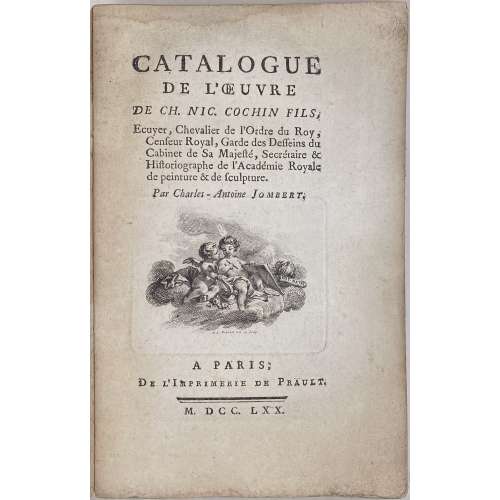 Description: one volume 20 x 12.8 cm, collated 8vo, in grey wrappers (original?), printed on laid paper, with tall “s”, two vignettes by Benoît-Louis Prévost to A1 and A3, 320 entries, where entry 320 Portraits et médaillons, consists of 121 entries itself. Title-page: CATALOGUE | DE L'ŒUVRE | DE CH. NIC. COCHIN FILS, | Ecuyer, Chevalier de l’Ordre du Roy, | Censeur Royal, Garde des Desseins du | Cabinet de Sa Majesté, Secrétaire & | Historiographe de l'Académie Royale | de peinture & de sculpture. | Par Charles-Antoine Jombert. | {vignette by Benoît-Louis Prévost} | A PARIS ; | De l’Imprimerie de Prault. | — | M. DCC. LXX. || Collation: A-I8, K1 (approbation), χ 8 (blanks), two in-text vignettes, total 81 leaves. Pagination: [1-5] 6-144 [145] [17 blanks], ils.; total 162 pages. Ref: Gallica-BnF. Contributors: Charles-Antoine Jombert (French, 1712 – 1784) – author. Charles Nicolas Cochin (French, 1715 – 1790) Benoît-Louis Prévost (French, 1735/47 – 1804) Laurent-François Prault (French, 1712 – 1780)
Description: one volume 20 x 12.8 cm, collated 8vo, in grey wrappers (original?), printed on laid paper, with tall “s”, two vignettes by Benoît-Louis Prévost to A1 and A3, 320 entries, where entry 320 Portraits et médaillons, consists of 121 entries itself. Title-page: CATALOGUE | DE L'ŒUVRE | DE CH. NIC. COCHIN FILS, | Ecuyer, Chevalier de l’Ordre du Roy, | Censeur Royal, Garde des Desseins du | Cabinet de Sa Majesté, Secrétaire & | Historiographe de l'Académie Royale | de peinture & de sculpture. | Par Charles-Antoine Jombert. | {vignette by Benoît-Louis Prévost} | A PARIS ; | De l’Imprimerie de Prault. | — | M. DCC. LXX. || Collation: A-I8, K1 (approbation), χ 8 (blanks), two in-text vignettes, total 81 leaves. Pagination: [1-5] 6-144 [145] [17 blanks], ils.; total 162 pages. Ref: Gallica-BnF. Contributors: Charles-Antoine Jombert (French, 1712 – 1784) – author. Charles Nicolas Cochin (French, 1715 – 1790) Benoît-Louis Prévost (French, 1735/47 – 1804) Laurent-François Prault (French, 1712 – 1780) -
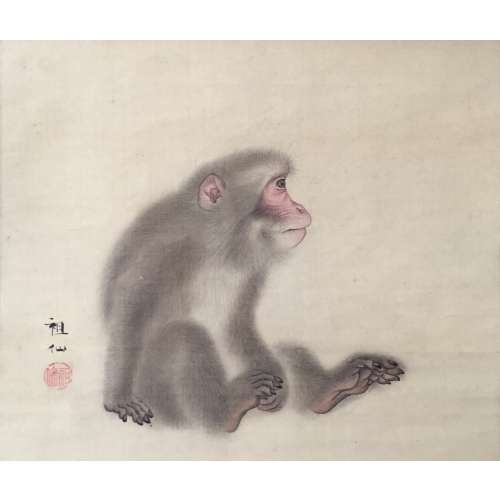 Mori Sosen (1747-1821). Seated Monkey. Hanging scroll painting. Ink and colour on silk. Signed: Sosen. Sealed: Sosen. 28.8 x 33.3 cm.
Mori Sosen (1747-1821). Seated Monkey. Hanging scroll painting. Ink and colour on silk. Signed: Sosen. Sealed: Sosen. 28.8 x 33.3 cm. -
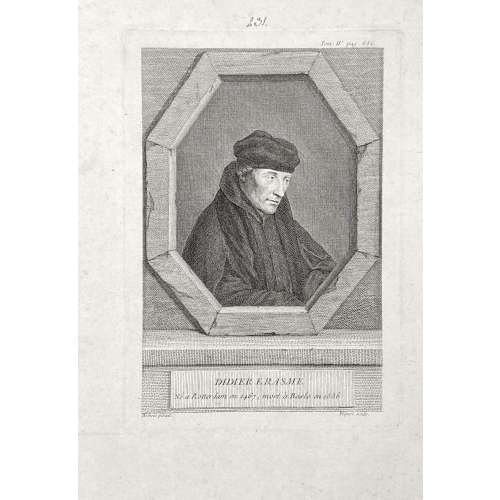 The portrait of Erasmus of Rotterdam (1466 – 1536), half-length, head to the right, body facing right, looking away, in a trompe-l'oeil octagonal frame. Inscriptions: Top right: Tom IV, pag. 686. Center of the image: DIDIER ERASME / Ne a Rotterdam en 1467, mort a Basle en 1536. Bottom of the plate: Holbein pinxit | Flipart Sculp. From the book Histoire générale des Provinces-Unies by Bénigne Dujardin (French, 1689 – 1771?) and Gottfried Sellius (real name Gottfried Sell) (1704? – 1767), published in 1757 in Paris by P. G. Simon. Volume 4, facing p. 686. Size: Sheet: 25 x 17.5 cm; Plate: 19.5 x 13.5 cm; Image: 18 x 12 cm. References: (1) Van Someren v.2, p.249, №1688; (2) https://archive.org/details/histoiregnra04duja/page/n714/mode/2up. Inscription above the plate: nut ink, hand, "231".
The portrait of Erasmus of Rotterdam (1466 – 1536), half-length, head to the right, body facing right, looking away, in a trompe-l'oeil octagonal frame. Inscriptions: Top right: Tom IV, pag. 686. Center of the image: DIDIER ERASME / Ne a Rotterdam en 1467, mort a Basle en 1536. Bottom of the plate: Holbein pinxit | Flipart Sculp. From the book Histoire générale des Provinces-Unies by Bénigne Dujardin (French, 1689 – 1771?) and Gottfried Sellius (real name Gottfried Sell) (1704? – 1767), published in 1757 in Paris by P. G. Simon. Volume 4, facing p. 686. Size: Sheet: 25 x 17.5 cm; Plate: 19.5 x 13.5 cm; Image: 18 x 12 cm. References: (1) Van Someren v.2, p.249, №1688; (2) https://archive.org/details/histoiregnra04duja/page/n714/mode/2up. Inscription above the plate: nut ink, hand, "231". -
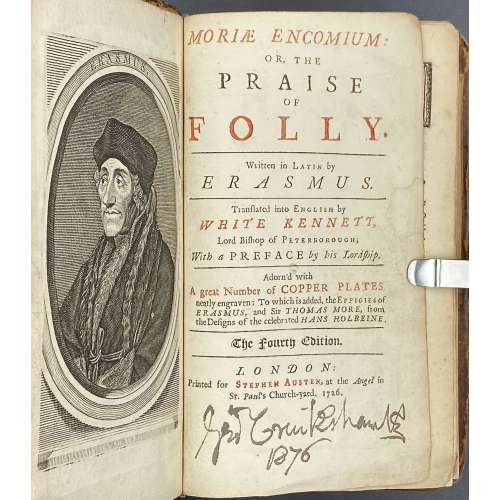 Erasmus. The praise of folly / Translated by White Kennett. — London: Stephen Austen, 1726. Title page in black and red: MORIÆ ENCOMIUM: | OR, THE | PRAISE | OF | FOLLY. |—| Written in Latin by | ERASMUS. |—| Translated into English by | WHITE KENNETT, | Lord Bishop of Peterborough; | With a PREFACE by his Lordship. |—| Adorn’d with | A great Number of COPPER PLATES | neatly engraven: To which is added, the Effigies of | ERASMUS, and Sir THOMAS MORE, from | theDesigns of the celebrated HANS HOLBEINE. |—| (in gothic letters) The Fourth Edition. |—| LONDON: | Printed for Stephen Austen, at the Angel in | St. Pauls’ Church-yard. 1726. || Pagination: modern endpapers and flyleaves, [2] – blank / frontis. (engraved portrait of Erasmus, [2] – t.p. in black and red with George Cruikshank’s signature in the bottom, dated 1876 / blank, [14] – to the reader, i-xiv – commendatory verses, [2] – John Wilford advert., folding portrait of Thomas More, i-v, [vi] - epistle, 1-168 – panegyrick, [4] – index.; 46 copper-engraved illustrations after Hans Holbein the Younger; pp. 17-20 detached. Collation: 12mo; π2 A6, a-b6, B-P6 Q2 (B3 unsigned), 13 in-text engravings + 26 plates + 7 folding plates; total 106 leaves and 33 plates, extraneous to collation. Edition: 4th, thus. Binding: 16.5 x 10.5 cm; rebacked with a modern spine, modern endpapers and flyleaves, contemporary boards sprinkled and tooled in a style of Cambridge panel. Provenance: Cruikshank, George (British, 1792 – 1878) [1876]; Stephen Whitehead (Oakland, CA) [2021]. Catalogue raisonné: J. Lewine (1898) p. 171 — 1st edition thus of 1709, in-8vo, with portrait and 46 plates after Holbein. Contributors: Desiderius Erasmus Roterodamus (Dutch, c. 1469 – 1536) – author of the original text in Latin.
Erasmus. The praise of folly / Translated by White Kennett. — London: Stephen Austen, 1726. Title page in black and red: MORIÆ ENCOMIUM: | OR, THE | PRAISE | OF | FOLLY. |—| Written in Latin by | ERASMUS. |—| Translated into English by | WHITE KENNETT, | Lord Bishop of Peterborough; | With a PREFACE by his Lordship. |—| Adorn’d with | A great Number of COPPER PLATES | neatly engraven: To which is added, the Effigies of | ERASMUS, and Sir THOMAS MORE, from | theDesigns of the celebrated HANS HOLBEINE. |—| (in gothic letters) The Fourth Edition. |—| LONDON: | Printed for Stephen Austen, at the Angel in | St. Pauls’ Church-yard. 1726. || Pagination: modern endpapers and flyleaves, [2] – blank / frontis. (engraved portrait of Erasmus, [2] – t.p. in black and red with George Cruikshank’s signature in the bottom, dated 1876 / blank, [14] – to the reader, i-xiv – commendatory verses, [2] – John Wilford advert., folding portrait of Thomas More, i-v, [vi] - epistle, 1-168 – panegyrick, [4] – index.; 46 copper-engraved illustrations after Hans Holbein the Younger; pp. 17-20 detached. Collation: 12mo; π2 A6, a-b6, B-P6 Q2 (B3 unsigned), 13 in-text engravings + 26 plates + 7 folding plates; total 106 leaves and 33 plates, extraneous to collation. Edition: 4th, thus. Binding: 16.5 x 10.5 cm; rebacked with a modern spine, modern endpapers and flyleaves, contemporary boards sprinkled and tooled in a style of Cambridge panel. Provenance: Cruikshank, George (British, 1792 – 1878) [1876]; Stephen Whitehead (Oakland, CA) [2021]. Catalogue raisonné: J. Lewine (1898) p. 171 — 1st edition thus of 1709, in-8vo, with portrait and 46 plates after Holbein. Contributors: Desiderius Erasmus Roterodamus (Dutch, c. 1469 – 1536) – author of the original text in Latin.White Kennett (British, 1660 – 1728) – translator from Latin into English.
Hans Holbein the Younger (German, 1497/8 – 1543) – artist.
Stephen Austen (fl. c. 1727 – 1746) – publisher. Linked items: Engraved portrait of Erasmus of Rotterdam in an octagonal frame, 1757 by Flipart after Holbein.Эразм Роттердамский. Похвальное слово глупости. — М.-Л.: Academia, 1932.
-
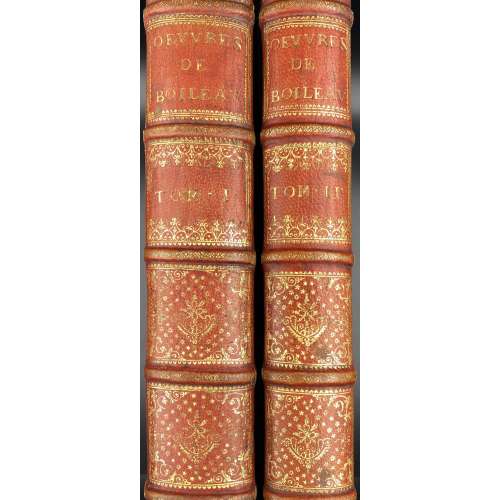 Description: two volumes, 38.3 x 25.5 cm each, uniformly bound in red morocco, boards decorated in gilt in the style of Luc-Antoine Boyet, with gilt dentelle inside out; spine with raised bands, gilt lettering, gilt in compartments; all edges gilt; marbled endpapers; printed on laid paper, text in the floral frame, engraved frontispiece (after Hyacinthe Rigaud), plates, t.p. vignette with the portrait of Desiderius Erasmus (after Quentin Metsys), head- and tailpieces (total of 40, some repeating) and 2 initials by Bernard Picart, folded portrait of dedicatee Guillelmine Charlotte Princesse de Galles &c &c &c by van Gunst after Kneller. Title-page (red and black, tall ‘s’): OEUVRES | DE | NICOLAS BOILEAU | DESPRÉAUX. | AVEC DES | ÉCLAIRCISSEMENTS | HISTORIQUES, | DONNEZ PAR LUI-MEME. | Nouvelle Edition revuë, corrigée & augmentée de diverses Remarques. | Enrichie de figures gravées par Bernard Picart le Romain. | TOME PREMIER (SECOND). | {vignette} | A AMSTERDAM, | Chez DAVID MORTIER. | — | M DCCXVIII. | AVEC PRIVILEGE. || Vol. 1. Collation: 4to; 1 ffl, a-c4 d1 A-3K4, 3L2, 1ffl; (K3 marked I3). Plates: t.p. vignette, frontispiece, 24 head- and tailpieces, f.t. in a grotesque frame and 6 full-page for ‘Le Lutrin’ in the same frame by Bernard Picart; folded portrait of Guillelmine Charlotte, Princess of Wales by van Gunst after Kneller. Pagination: [4] [i-v] vi-xviii [4] [1] 2-450 [2]. Vol. 2. Collation: 4to; 2 ffl, π2 A-3C4 3D3 2 ffl; (V3 marked T3, 2L4 marked A). Plates: t.p. vignette (same as vol.1) and 7 head- and tailpieces by Bernard Picart. Pagination: [4] [i-iii] iv-vii [viii] [1] 2-370 [2] [20]. Catalogue raisonné: Lewine 72-3; Cohen-De Ricci 165-6. Contributors: Luc-Antoine Boyet (French, fl. 1684 – 1733) – bookbinder. Claude Brossette (French, 1671 – 1743) – author, remarks. André Dacier (French, 1651 – 1722) – author, preface. Nicolas Boileau Despréaux (French, 1636 – 1711) – author. Pieter Stevens van Gunst (Dutch, 1659-1724) – engraver. Sir Godfrey Kneller (British, 1646-1723) – artist. David Mortier (Dutch-British, 1673 – 1728) – publisher. Bernard Picard (French, 1673 – 1733) – artist, engraver. Quentin Massijs [Metsys, Matsys] (Flemish, 1466 – 1530) – artist. Hyacinthe Rigaud [Jacint Rigau-Ros i Serra] (French, 1659 - 1743) – artist. Guillelmine Charlotte, Princess of Wales (Wilhelmina Charlotte Caroline of Brandenburg-Ansbach) (1683 – 1737) – dedicatee
Description: two volumes, 38.3 x 25.5 cm each, uniformly bound in red morocco, boards decorated in gilt in the style of Luc-Antoine Boyet, with gilt dentelle inside out; spine with raised bands, gilt lettering, gilt in compartments; all edges gilt; marbled endpapers; printed on laid paper, text in the floral frame, engraved frontispiece (after Hyacinthe Rigaud), plates, t.p. vignette with the portrait of Desiderius Erasmus (after Quentin Metsys), head- and tailpieces (total of 40, some repeating) and 2 initials by Bernard Picart, folded portrait of dedicatee Guillelmine Charlotte Princesse de Galles &c &c &c by van Gunst after Kneller. Title-page (red and black, tall ‘s’): OEUVRES | DE | NICOLAS BOILEAU | DESPRÉAUX. | AVEC DES | ÉCLAIRCISSEMENTS | HISTORIQUES, | DONNEZ PAR LUI-MEME. | Nouvelle Edition revuë, corrigée & augmentée de diverses Remarques. | Enrichie de figures gravées par Bernard Picart le Romain. | TOME PREMIER (SECOND). | {vignette} | A AMSTERDAM, | Chez DAVID MORTIER. | — | M DCCXVIII. | AVEC PRIVILEGE. || Vol. 1. Collation: 4to; 1 ffl, a-c4 d1 A-3K4, 3L2, 1ffl; (K3 marked I3). Plates: t.p. vignette, frontispiece, 24 head- and tailpieces, f.t. in a grotesque frame and 6 full-page for ‘Le Lutrin’ in the same frame by Bernard Picart; folded portrait of Guillelmine Charlotte, Princess of Wales by van Gunst after Kneller. Pagination: [4] [i-v] vi-xviii [4] [1] 2-450 [2]. Vol. 2. Collation: 4to; 2 ffl, π2 A-3C4 3D3 2 ffl; (V3 marked T3, 2L4 marked A). Plates: t.p. vignette (same as vol.1) and 7 head- and tailpieces by Bernard Picart. Pagination: [4] [i-iii] iv-vii [viii] [1] 2-370 [2] [20]. Catalogue raisonné: Lewine 72-3; Cohen-De Ricci 165-6. Contributors: Luc-Antoine Boyet (French, fl. 1684 – 1733) – bookbinder. Claude Brossette (French, 1671 – 1743) – author, remarks. André Dacier (French, 1651 – 1722) – author, preface. Nicolas Boileau Despréaux (French, 1636 – 1711) – author. Pieter Stevens van Gunst (Dutch, 1659-1724) – engraver. Sir Godfrey Kneller (British, 1646-1723) – artist. David Mortier (Dutch-British, 1673 – 1728) – publisher. Bernard Picard (French, 1673 – 1733) – artist, engraver. Quentin Massijs [Metsys, Matsys] (Flemish, 1466 – 1530) – artist. Hyacinthe Rigaud [Jacint Rigau-Ros i Serra] (French, 1659 - 1743) – artist. Guillelmine Charlotte, Princess of Wales (Wilhelmina Charlotte Caroline of Brandenburg-Ansbach) (1683 – 1737) – dedicatee -
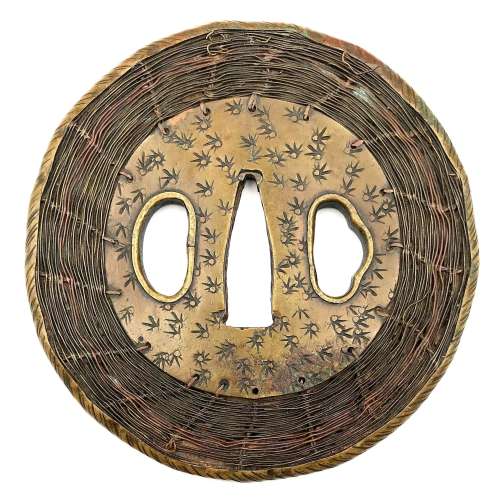 Shingen school (or style) tsuba of round form with iron core and web, covered with a thin brass plate decorated with star-shaped punch marks. The rim of tsuba is a brass nawame-fukurin. Between the central brass plate and the rim there is woven wire of brass and copper in a basketweave pattern. Both hitsu-ana have raised rim. Traces of oxidation. Unsigned. Edo period, 18th century. Size: Height: 88.4 mm, Width: 86.6 mm, Thickness at seppa-dai: 4.6 mm. Weight: 132.4 g. Robert E. Haynes in his "Study Collection of Japanese Sword Fittings. Nihon Art Publishers, 2010" on p. 117 says: "Brass outer plate of round shape. This tsuba has an iron core tsuba of spoke form as made by Saotome school, ca. 1500. There are brass plates on either side connected to the rim by woven brass and shakudō wire. The wire has been hand drawn, which is very difficult. The hitsuana are brass lined and the rim has a brass cover. This type of tsuba is referred to as a Shingen tsuba. This is a reference to Takeda Shingen Harunobu (1521-1573), the great and famous daimyō." For reference see the MFA collection. A look-a-like tsuba is illustrated in Compton Collection, vol. 2, p. 26-27, №52:More details and examples can be found at: http://varshavskycollection.com/shingen-tsuba/
Shingen school (or style) tsuba of round form with iron core and web, covered with a thin brass plate decorated with star-shaped punch marks. The rim of tsuba is a brass nawame-fukurin. Between the central brass plate and the rim there is woven wire of brass and copper in a basketweave pattern. Both hitsu-ana have raised rim. Traces of oxidation. Unsigned. Edo period, 18th century. Size: Height: 88.4 mm, Width: 86.6 mm, Thickness at seppa-dai: 4.6 mm. Weight: 132.4 g. Robert E. Haynes in his "Study Collection of Japanese Sword Fittings. Nihon Art Publishers, 2010" on p. 117 says: "Brass outer plate of round shape. This tsuba has an iron core tsuba of spoke form as made by Saotome school, ca. 1500. There are brass plates on either side connected to the rim by woven brass and shakudō wire. The wire has been hand drawn, which is very difficult. The hitsuana are brass lined and the rim has a brass cover. This type of tsuba is referred to as a Shingen tsuba. This is a reference to Takeda Shingen Harunobu (1521-1573), the great and famous daimyō." For reference see the MFA collection. A look-a-like tsuba is illustrated in Compton Collection, vol. 2, p. 26-27, №52:More details and examples can be found at: http://varshavskycollection.com/shingen-tsuba/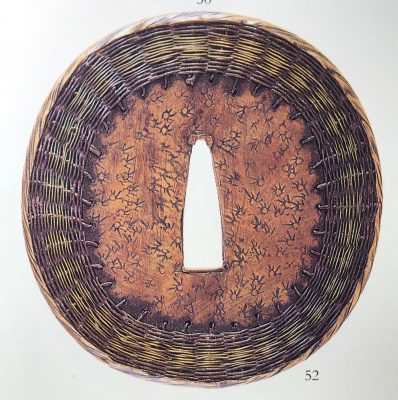
Compton Collection, vol. 2, p. 26-27, №52.
-
 The print lacks signature. It is attributed by some to Suzuki Harunobu and by the others to Isoda Koryūsai.
The print lacks signature. It is attributed by some to Suzuki Harunobu and by the others to Isoda Koryūsai.Attributed to Koryūsai: Pins #517/p.209, c. 1775 [AIC II: Clarence Buckingham Collection, 1925.2772], Ukiyo-e Taisei IV; Vignier & Inada, 1911; Ritsumeikan University Z0165-239.
Attributed to Harunobu: Pins #239/p.132.; BM 1906,1220,0.85;
-
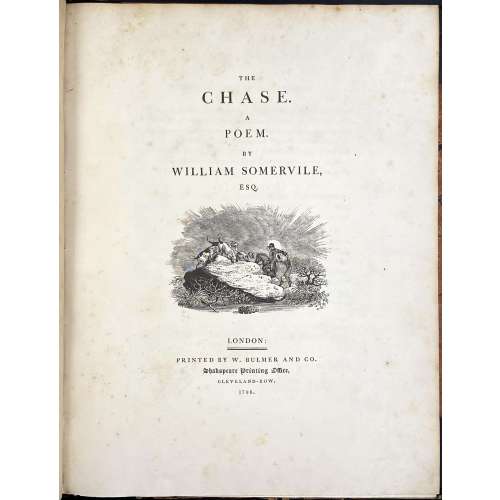 Royal 4to, 29.8 x 23.5 cm, contemporary half brown morocco, marbled boards gilt ruled, spine with gilt-ruled raised bands, gilt title lettering; "William Gore" armorial bookplate to front pastedown. Title page: THE | CHASE. | A | POEM. | BY | WILLIAM SOMERVILLE, | ESQ. | [VIGNETTE] | LONDON : | PRINTED BY W. BULMER AND CO. | Shakespeare Printing Office, | CLEVELAND-ROW. | 1796. Collation: without signatures. — Pagination: [i-v] vi-xv [xvi], [i] ii-vii [viii], [1-5] 6-126; illustrations: engraved title, 4 running titles, 4 headpieces, 4 tailpieces – 13 altogether, all drafted by John Bewick, 12 executed by Thomas Bewick and the last one by Charlton Nesbit. Catalogue Raisonné: Thomas Hugo. The Bewick Collector, vol. 1 (1866): p. 38, № 94: "The first edition... was printed in royal 4to". John Bewick made all the drawing on the blocks but was not able to execute the engravings himself "because of ill-health. They were engraved by Thomas Bewick, with the exception of the tail-piece at the end of the volume, which was engraved by Nesbit". Thomas Bewick (c. 11 August 1753 – 8 November 1828); John Bewick (1760 – 1795), the younger brother of Thomas, died at the age of 35. Christie's, who sold a similar copy on 29 Oct 2012, provides for the size 2°.
Royal 4to, 29.8 x 23.5 cm, contemporary half brown morocco, marbled boards gilt ruled, spine with gilt-ruled raised bands, gilt title lettering; "William Gore" armorial bookplate to front pastedown. Title page: THE | CHASE. | A | POEM. | BY | WILLIAM SOMERVILLE, | ESQ. | [VIGNETTE] | LONDON : | PRINTED BY W. BULMER AND CO. | Shakespeare Printing Office, | CLEVELAND-ROW. | 1796. Collation: without signatures. — Pagination: [i-v] vi-xv [xvi], [i] ii-vii [viii], [1-5] 6-126; illustrations: engraved title, 4 running titles, 4 headpieces, 4 tailpieces – 13 altogether, all drafted by John Bewick, 12 executed by Thomas Bewick and the last one by Charlton Nesbit. Catalogue Raisonné: Thomas Hugo. The Bewick Collector, vol. 1 (1866): p. 38, № 94: "The first edition... was printed in royal 4to". John Bewick made all the drawing on the blocks but was not able to execute the engravings himself "because of ill-health. They were engraved by Thomas Bewick, with the exception of the tail-piece at the end of the volume, which was engraved by Nesbit". Thomas Bewick (c. 11 August 1753 – 8 November 1828); John Bewick (1760 – 1795), the younger brother of Thomas, died at the age of 35. Christie's, who sold a similar copy on 29 Oct 2012, provides for the size 2°. -
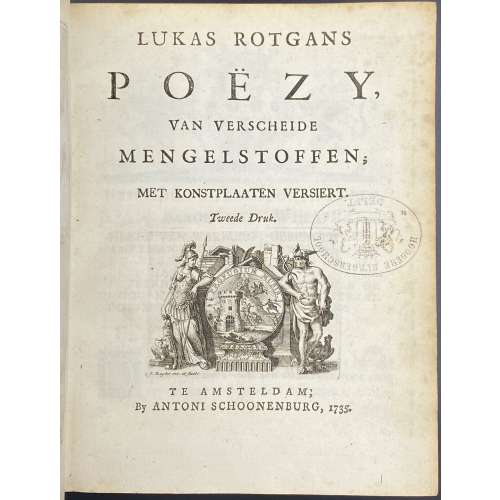 Title-page: LUKAS ROTGANS | POËZY, | VAN VERSCHEIDE | MENGELSTOFFEN; | MET KONSTPLAATEN VERSIERT. | Tweede Druk | {vignette} | TE AMSTERDAM; | By ANTONI SCHOONENBURG, 1735. || Collation: 4to; fep, 1st blank, engraved t.p. by M. Pool, t.p., *3,4; 2*-9*4, 10*1, *LII2, *LII, 10*2 —> *-10*4 (40 leaves); A-Z4, 2A-2Z4, 3A-3Z4, 4A-4Q4, last blank, fep; (340 leaves), 2 plates extraneous to collation. Pagination: [2] [1-5] 6-14 [15-80] [1-3] 4-680 [2], 2 unsigned plates not included in pagination after pp. 634 and 652, 50 headpieces by Jacob Folkema after Arnold Houbraken, and 2 tailpieces by Jan de Ruijter. Marks: Armorial bookplate: “Ex Libris J. J. Mak | {coat of arms} | Inveni Intermanere Melius”. Oval ink stamp: “HOOGERE BURGERSCHOOL. | DELFT” Provenance: Johannes Jacobus Mak (Dutch, 1908 – 1975). Edition: 2nd, 1st edition published in 1715 in Leeuwarden by François Halma. Contributors: Lukas Rotgans (Dutch, 1653 – 1710) – author. Arnold Houbraken (Dutch, 1660 – 1719) – artist. Jacob Folkema (Dutch, 1692 – 1767) – engraver. Matthijs Pool (Dutch, 1676 – 1740) – engraver. Jan de Ruijter (Dutch, 1688 – 1744) – engraver. Antoni Schoonenburg (Dutch, 1682 – 1754) – publisher.
Title-page: LUKAS ROTGANS | POËZY, | VAN VERSCHEIDE | MENGELSTOFFEN; | MET KONSTPLAATEN VERSIERT. | Tweede Druk | {vignette} | TE AMSTERDAM; | By ANTONI SCHOONENBURG, 1735. || Collation: 4to; fep, 1st blank, engraved t.p. by M. Pool, t.p., *3,4; 2*-9*4, 10*1, *LII2, *LII, 10*2 —> *-10*4 (40 leaves); A-Z4, 2A-2Z4, 3A-3Z4, 4A-4Q4, last blank, fep; (340 leaves), 2 plates extraneous to collation. Pagination: [2] [1-5] 6-14 [15-80] [1-3] 4-680 [2], 2 unsigned plates not included in pagination after pp. 634 and 652, 50 headpieces by Jacob Folkema after Arnold Houbraken, and 2 tailpieces by Jan de Ruijter. Marks: Armorial bookplate: “Ex Libris J. J. Mak | {coat of arms} | Inveni Intermanere Melius”. Oval ink stamp: “HOOGERE BURGERSCHOOL. | DELFT” Provenance: Johannes Jacobus Mak (Dutch, 1908 – 1975). Edition: 2nd, 1st edition published in 1715 in Leeuwarden by François Halma. Contributors: Lukas Rotgans (Dutch, 1653 – 1710) – author. Arnold Houbraken (Dutch, 1660 – 1719) – artist. Jacob Folkema (Dutch, 1692 – 1767) – engraver. Matthijs Pool (Dutch, 1676 – 1740) – engraver. Jan de Ruijter (Dutch, 1688 – 1744) – engraver. Antoni Schoonenburg (Dutch, 1682 – 1754) – publisher. -
 Print by Katsukawa Shun'ei that presumably depicts a kabuki actor Ichikawa Monnosuke II. I was not able to find any reference of the image. Size: Hosoban. SOLD
Print by Katsukawa Shun'ei that presumably depicts a kabuki actor Ichikawa Monnosuke II. I was not able to find any reference of the image. Size: Hosoban. SOLD -
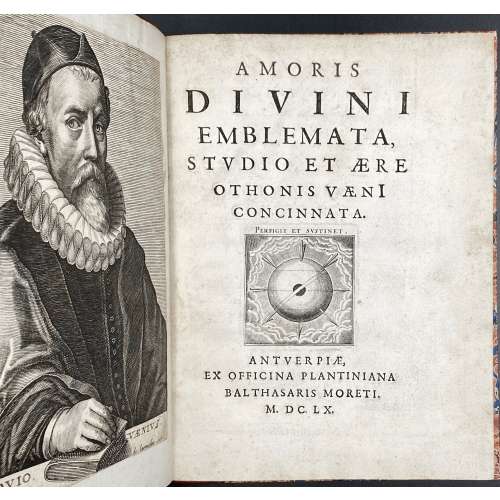 Amoris Divini Emblemata, Studio Et Aere Othonis Vaeni Concinata. — Antverpiae: Ex Officina Plantiniana Balthasaris Moreti, MDCLX [1660]. — pp.: [1] (Van Veen port.), [1] title, [2] (Isabella port.), 3-127 [1], 60 illustr. — 2nd impression. Octavius Vaenius, a.k.a. Otto Vaenius or Otto Van Veen (c. 1556-1629) was Rubens's last and most influential teacher. The Amoris divini emblemata was first published in 1615 by Nutius & Meursius in Antwerp. Vaenius’s book was to influence Herman Hugo's Pia desideria (LIB-1657.2018). Book structure: On frontispiece, trimmed and mounted portrait of Octavius Vaenius painted by his daughter Gertruida van Veen (signed Gertrudis filia) and engraved by Nicolas de Larmessin. Trimmed portrait of the Infanta Isabella Clara of Austria (1566 – 1633) pained by Peter Paul Rubens and engraved by Jan de Leeuw mounted to title verso. 60 engraved plates with emblems are on recto pages with facing texts: Latin quotations from Bible and Fathers, Spanish verses by Alphonso de Ledesma, Dutch by Vaenius and French by Carolus Philippus Hattron (d. 1632). Rebound in the mid-19th century in brown quarter Morocco with blind marbled boards and gilt lettering to spine. Inscription in ink on verso to van Veen portrait: "I bought this volume with the portraits inserted at the sale of the library of my uncle Samuel Rogers, Esq." Signed: "Frederick Sharpe, 1856". Frederick Sharpe (born was a son of Samuel Sharpe (1799–1881), the nephew of Samuel Rogers (1763–1855), a celebrated English poet. Size: 23.3 x 17.9 cm. Ref.: Emblem Project Utrecht (with an explanation of all the emblems); PETER BOOTHUYGENS: Similar or Dissimilar Loves?
Amoris Divini Emblemata, Studio Et Aere Othonis Vaeni Concinata. — Antverpiae: Ex Officina Plantiniana Balthasaris Moreti, MDCLX [1660]. — pp.: [1] (Van Veen port.), [1] title, [2] (Isabella port.), 3-127 [1], 60 illustr. — 2nd impression. Octavius Vaenius, a.k.a. Otto Vaenius or Otto Van Veen (c. 1556-1629) was Rubens's last and most influential teacher. The Amoris divini emblemata was first published in 1615 by Nutius & Meursius in Antwerp. Vaenius’s book was to influence Herman Hugo's Pia desideria (LIB-1657.2018). Book structure: On frontispiece, trimmed and mounted portrait of Octavius Vaenius painted by his daughter Gertruida van Veen (signed Gertrudis filia) and engraved by Nicolas de Larmessin. Trimmed portrait of the Infanta Isabella Clara of Austria (1566 – 1633) pained by Peter Paul Rubens and engraved by Jan de Leeuw mounted to title verso. 60 engraved plates with emblems are on recto pages with facing texts: Latin quotations from Bible and Fathers, Spanish verses by Alphonso de Ledesma, Dutch by Vaenius and French by Carolus Philippus Hattron (d. 1632). Rebound in the mid-19th century in brown quarter Morocco with blind marbled boards and gilt lettering to spine. Inscription in ink on verso to van Veen portrait: "I bought this volume with the portraits inserted at the sale of the library of my uncle Samuel Rogers, Esq." Signed: "Frederick Sharpe, 1856". Frederick Sharpe (born was a son of Samuel Sharpe (1799–1881), the nephew of Samuel Rogers (1763–1855), a celebrated English poet. Size: 23.3 x 17.9 cm. Ref.: Emblem Project Utrecht (with an explanation of all the emblems); PETER BOOTHUYGENS: Similar or Dissimilar Loves? -
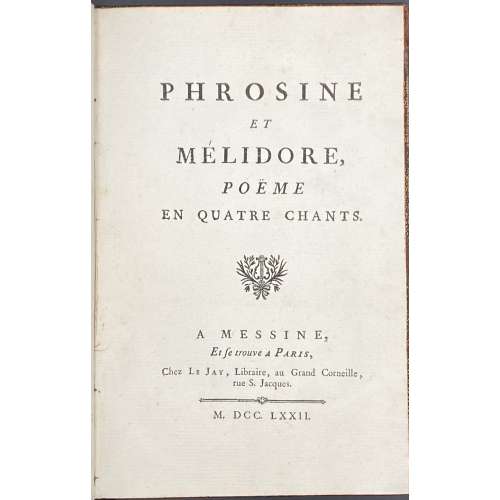 Title page: PHROSINE | ET | MELIDORE, | POËME | EN QUATRE CHANTS. | A MESSINE, | Et se trouve A Paris, | Chez Le Jay, Libraire, au Grand Corneille, | rue S. Jacques. | M. DCC. LXXII. || Pagination : ffl, [2] – h.t. / blank, [2] t.p. / blank, [1] 2-55 [56 blank], bfl ; 4 copperplate engravings by Nicolas Ponce (French, 1746 – 1831) after Charles Eisen (French, 1720 – 1778), one before each chant. Collation: 8vo; π2 (h.t., t.p. ) A-C8 D4. Binding: 20.5 x 14 cm, full mottled calf, gilt-ruled with triple fillet, flat spine, gilt in compartments, black label with gilt lettering, printed on laid paper, all edges red. Catalogue raisonné: Cohen de Ricci p. 132; J. Lewine: p. 53. Contributors: Nicolas Ponce (French, 1746 – 1831) Jean Charles Baquoy (French, 1721–1777) Charles-Dominique-Joseph Eisen (French, 1720 – 1778) Pierre-Joseph Bernard [Gentil-Bernard] (French, 1708 – 1775).
Title page: PHROSINE | ET | MELIDORE, | POËME | EN QUATRE CHANTS. | A MESSINE, | Et se trouve A Paris, | Chez Le Jay, Libraire, au Grand Corneille, | rue S. Jacques. | M. DCC. LXXII. || Pagination : ffl, [2] – h.t. / blank, [2] t.p. / blank, [1] 2-55 [56 blank], bfl ; 4 copperplate engravings by Nicolas Ponce (French, 1746 – 1831) after Charles Eisen (French, 1720 – 1778), one before each chant. Collation: 8vo; π2 (h.t., t.p. ) A-C8 D4. Binding: 20.5 x 14 cm, full mottled calf, gilt-ruled with triple fillet, flat spine, gilt in compartments, black label with gilt lettering, printed on laid paper, all edges red. Catalogue raisonné: Cohen de Ricci p. 132; J. Lewine: p. 53. Contributors: Nicolas Ponce (French, 1746 – 1831) Jean Charles Baquoy (French, 1721–1777) Charles-Dominique-Joseph Eisen (French, 1720 – 1778) Pierre-Joseph Bernard [Gentil-Bernard] (French, 1708 – 1775). -
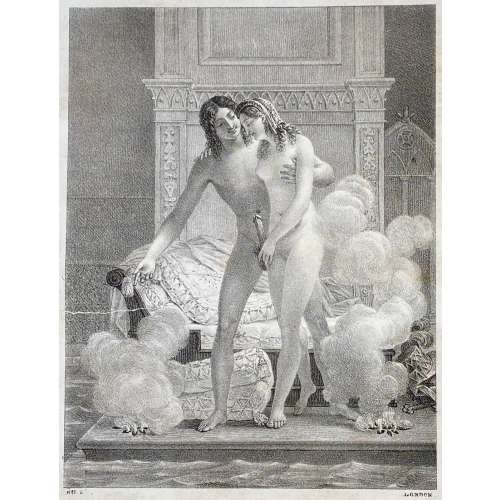 Description: Two volumes in one, collated 4to, 32.5 x 25.3 cm, bound in 19th-century long-grain green shagreen, flapped portfolio with a bronze lock clasp, gilt centrepiece fleuron, gilt- and blind-tooled boards and spine, spine with false raised bands, gilt-lettered "ESSAI | SUR LA MORALE"; text printed on bluish laid paper, blue marbled pastedowns; h.t. and t.p. in both volumes present. Restoration and conservation by Zukor art conservation in September 2022. Title-page: LA PUCELLE | D'ORLÉANS, | POËME EN VINGT-UN CHANTS. | Par VOLTAIRE | Édition ornée de Figures gravées par les meilleurs | Artistes de Paris. | — | TOME PREMIER (TOME SECOND). | — | A PARIS, | DE L’IMPRIMERIE DE DIDOT LE JEUNE. | L’AN TROISIÈME. || Imprint: A PARIS, | Chez les Frères Jacquenod, rue de Condé, no. 15. | A LYON, chez les mêmes. || Collation: Vol. 1: A-Z4, 2A-2H4 2I2; total 126 leaves; Vol. 2: A-Z4, 2A4 2B2, 2C-D4, 2E3 2F-2N4; total 141 leaves; first and last blank, plus 21 plates extraneous to collation, 8 in the 1st volume (incl. frontispiece) and 13 in the 2nd. Pagination: Vol. 1: [1-5] 6-251 [252], total 252 pages, ils; Note: leave 2A1 has a loss of 1/6 of the top, leave 2A2 torn out completely; Vol. 2: [1-5] 6-212, 2[211] 2212 [213] 214-279 [280], duplication of numbers 211 and 212 => total 282 pages, ils. The total number of pages in the volume is 534; one page torn out (187/8 in Vol. 1) Catalogue raisonné: Nordmann (2): № 562, p. 278; Cohen-deRicci: 1034. According to Nordmann (Christie’s), it was an edition illustrated with 21 plates after Lebarbier, Marillier, Monnet and Monsiau produced by various engravers; in the 1840s those plates were replaced with 24 lithographs by Achille Devéria, who signed them “LONDON”. In Nordmann’s copy, there is also a set of hand-coloured lithographs. There are only 21 plates in our copy, lacking three as per the source. Contributors : François Marie Arouet de Voltaire (French, 1694 – 1778) – author. Achille Devéria (French, 1800 – 1857) – artist. Pierre-Nicolas-Firmin Didot [Didot le Jeune] (French, 1769 – 1836) – publisher.
Description: Two volumes in one, collated 4to, 32.5 x 25.3 cm, bound in 19th-century long-grain green shagreen, flapped portfolio with a bronze lock clasp, gilt centrepiece fleuron, gilt- and blind-tooled boards and spine, spine with false raised bands, gilt-lettered "ESSAI | SUR LA MORALE"; text printed on bluish laid paper, blue marbled pastedowns; h.t. and t.p. in both volumes present. Restoration and conservation by Zukor art conservation in September 2022. Title-page: LA PUCELLE | D'ORLÉANS, | POËME EN VINGT-UN CHANTS. | Par VOLTAIRE | Édition ornée de Figures gravées par les meilleurs | Artistes de Paris. | — | TOME PREMIER (TOME SECOND). | — | A PARIS, | DE L’IMPRIMERIE DE DIDOT LE JEUNE. | L’AN TROISIÈME. || Imprint: A PARIS, | Chez les Frères Jacquenod, rue de Condé, no. 15. | A LYON, chez les mêmes. || Collation: Vol. 1: A-Z4, 2A-2H4 2I2; total 126 leaves; Vol. 2: A-Z4, 2A4 2B2, 2C-D4, 2E3 2F-2N4; total 141 leaves; first and last blank, plus 21 plates extraneous to collation, 8 in the 1st volume (incl. frontispiece) and 13 in the 2nd. Pagination: Vol. 1: [1-5] 6-251 [252], total 252 pages, ils; Note: leave 2A1 has a loss of 1/6 of the top, leave 2A2 torn out completely; Vol. 2: [1-5] 6-212, 2[211] 2212 [213] 214-279 [280], duplication of numbers 211 and 212 => total 282 pages, ils. The total number of pages in the volume is 534; one page torn out (187/8 in Vol. 1) Catalogue raisonné: Nordmann (2): № 562, p. 278; Cohen-deRicci: 1034. According to Nordmann (Christie’s), it was an edition illustrated with 21 plates after Lebarbier, Marillier, Monnet and Monsiau produced by various engravers; in the 1840s those plates were replaced with 24 lithographs by Achille Devéria, who signed them “LONDON”. In Nordmann’s copy, there is also a set of hand-coloured lithographs. There are only 21 plates in our copy, lacking three as per the source. Contributors : François Marie Arouet de Voltaire (French, 1694 – 1778) – author. Achille Devéria (French, 1800 – 1857) – artist. Pierre-Nicolas-Firmin Didot [Didot le Jeune] (French, 1769 – 1836) – publisher. -
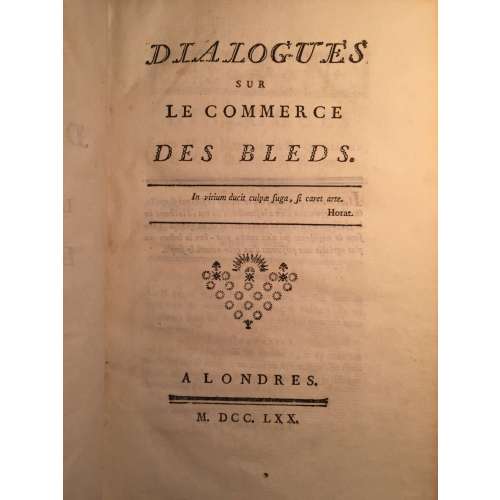
GALIANI, Ferdinando, Abbé. Dialogue sur le commerce des bleds. Londres, 1770. L'Abbé Roubaud, Pierre Joseph André. Récréations économiques ou lettres de l'auteur des représentations aux magistrats, a M. le chevalier Zanobi, principal interlocuteur des Dialogues sur le commerce des bleds; Amsterdam & Paris, Delalain, 1770. Béguillet, Edme. De principiis vegetationis et agreculturae et de causis triplicis culturae in Burgundia disquisitio physica. Auctore E.B.D. ex Societate Œconomica Lugdunensi; Divione, 1768.
-

Iron tsuba of oval form with the design of two immortals (Gama Sennin with the toad upon his head and Tekkai Sennin with his iron crutch) beside a waterfall carved in low relief with a high relief effect (takabori) and with details inlaid in gold. A waterfall carved on the reverse. Nakago-ana is plugged with copper sekigane. Unsigned. Allegedly, Mito School.
Edo period, ca. 1700.
Size: Height: 87.0 mm; Width: 82.8 mm; Thickness: 4.4 mm; Weight: 179 g.
No longer available.


